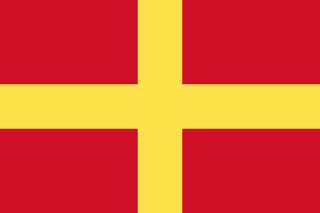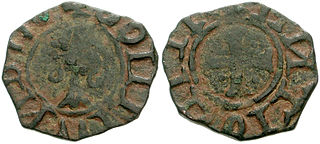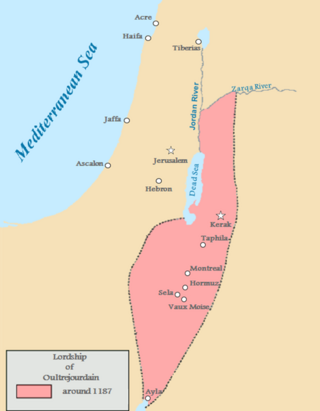
The Crusader states, or Outremer, were four Catholic polities that existed in the Levant from 1098 to 1291. Following the principles of feudalism, the foundation for these polities was laid by the First Crusade, which was proclaimed by the Latin Church in 1095 in order to reclaim the Holy Land after it was lost to the 7th-century Muslim conquest. Situated on the Eastern Mediterranean, the four states were, in order from north to south: the County of Edessa (1098–1150), the Principality of Antioch (1098–1268), the County of Tripoli (1102–1289), and the Kingdom of Jerusalem (1099–1291). The three northern states covered an area in what is now southeastern Turkey, northwestern Syria, and northern Lebanon; and the Kingdom of Jerusalem, the southernmost and most prominent state, covered an area in what is now Israel, Palestine, southern Lebanon, and western Jordan. The description "Crusader states" can be misleading, as from 1130 onwards, very few people among the Franks were Crusaders. Medieval and modern writers use the term "Outremer" as a synonym, derived from the French word for overseas.

The County of Tripoli (1102–1289) was one of the Crusader states. It was founded in the Levant in the modern-day region of Tripoli, northern Lebanon and parts of western Syria. When the Frankish Crusaders, mostly southern French forces – captured the region in 1109, Bertrand of Toulouse became the first count of Tripoli as a vassal of King Baldwin I of Jerusalem. From that time on, the rule of the county was decided not strictly by inheritance but by factors such as military force, favour and negotiation. In 1289, the County of Tripoli fell to the Muslim Mamluks of Cairo under Sultan Qalawun, and the county was absorbed into Mamluk Sultanate.
The Patriarch of Antioch is a traditional title held by the bishop of Antioch. As the traditional "overseer" of the first gentile Christian community, the position has been of prime importance in Pauline Christianity from its earliest period. This diocese is one of the few for which the names of its bishops from the apostolic beginnings have been preserved. Today five churches use the title of patriarch of Antioch: one Oriental Orthodox ; three Eastern Catholic ; and one Eastern Orthodox.

Bohemond IV of Antioch, also known as Bohemond the One-Eyed, was Count of Tripoli from 1187 to 1233, and Prince of Antioch from 1201 to 1216 and from 1219 to 1233. He was the younger son of Bohemond III of Antioch. The dying Raymond III of Tripoli offered his county to Bohemond's elder brother, Raymond, but their father sent Bohemond to Tripoli in late 1187. Saladin, the Ayyubid sultan of Egypt and Syria, conquered the county, save for the capital and two fortresses, in summer 1188.
Alberic of Ostia (1080–1148) was a Benedictine monk, diplomat and Cardinal Bishop of Ostia from 1138 to 1148. He was one of the most important people in the administration of Pope Eugenius III, especially due to his diplomatic skills.

Aimery or Aymery of Limoges, also Aimericus in Latin, Aimerikos in Greek and Hemri in Armenian, was a Roman Catholic ecclesiarch in Frankish Outremer and the fourth Latin Patriarch of Antioch from c. 1140 until his death. Throughout his lengthy episcopate he was the most powerful figure in the Principality of Antioch after the princes, and often entered into conflict with them. He was also one of the most notable intellectuals to rise in the Latin East.
William of Malines was a Flemish priest who was the Prior of the Church of the Holy Sepulchre from 1127 to 1130 and was then Latin Patriarch of Jerusalem from 1130 until his death. He is sometimes called William I to distinguish him from William of Agen, second patriarch of that name, but he was the second William to serve as prior of the Holy Sepulchre after William the Englishman.
The Apostolic Vicariate of Beirut is a Latin Church ecclesiastical jurisdiction or apostolic vicariate of the Catholic Church in Lebanon, where Eastern Catholics are far more numerous. In 2010, there were 15,000 baptized. Its current bishop is Cesar Essayan.
Opizzo Fieschi, also known as Opizo or Opiso dei' Fieschi, was a 13th-century Italian cleric from the powerful Genovese Fieschi family. Following his uncle Sinibaldo's election as Pope Innocent IV, Opizzo was appointed the Catholic Church's patriarch of Antioch.

Guerricus was the metropolitan archbishop of Petra from 1167 or 1168 until his death at the Siege of Acre in 1190 or 1191. He was the only archbishop of Petra from the Crusader period and its only Latin Catholic bishop from the Middle Ages. Politically, his see belonged to the Kingdom of Jerusalem and roughly corresponded geographically to the secular Lordship of Oultrejordain.

The timeline of the Kingdom of Jerusalem presents important events in the history of the Kingdom of Jerusalem—a Crusader state in modern day Israel and Jordan—in chronological order. The kingdom was established after the First Crusade in 1099. Its first ruler Godfrey of Bouillon did not take the title of king and swore fealty to the Latin Patriarch of Jerusalem, Daimbert. Godfrey's brother and successor Baldwin I was crowned the first king of Jerusalem without doing homage to the patriarch in 1100. By 1153, Baldwin I and his successors captured all towns on the Palestinian coast with the support of Pisan, Genoese and Venetian fleets and also took control of the caravan routes between Egypt and Syria. The kings regularly administered other crusader states—the Counties of Edessa and Tripoli and the Principality of Antioch—on behalf of their absent or underage rulers.
The Roman Catholic Archdiocese of Tyre was an archbishopric in the Kingdom of Jerusalem.
William I was the second Latin archbishop of Tyre from 1128 until 1134 or 1135. He was originally from England and served as prior of the Church of the Holy Sepulchre before his appointment as archbishop.

Philip of Tripoli, sometimes Philippus Tripolitanus or Philip of Foligno, was an Italian Catholic priest and translator. Although he had a markedly successful clerical career, his most enduring legacy is his translation of the complete Pseudo-Aristotelian Secretum secretorum from Arabic into Latin around 1230.
The Latin Diocese of Tripoli was established in 1104 in the aftermath of the First Crusade. It remained a residential bishopric until 1289, after which it became a titular bishopric, which it remains today in the Catholic Church.
Paul of Segni was an Italian nobleman and Franciscan friar who served as the bishop of Tripoli in the Levant from 1261 until 1285 and as a papal legate to the kingdoms of Germany and Sicily in 1279–1280. He was the most prominent churchman from the east at the Second Council of Lyon in 1274. After 1275, he was involved in a dispute with the bishop of Tortosa that took him to Rome. He spent his last five years in Italy.
Guy II or Guido II, surnamed Embriaco, was the lord of Gibelet from about 1271 until his death.
The Abbey of Saint Lazarus was a Benedictine convent in Bethany in the Kingdom of Jerusalem. It was founded in 1138 by Queen Melisende and King Fulk at the reputed site of the tomb of Lazarus. The queen lavishly endowed the abbey, making it richer than any other religious community in the kingdom. It lost much of its estates, including Bethany itself, during the Muslim reconquests of the Latin East, and retreated to the Kingdom of Cyprus, where it faded into obscurity in the 14th century. Parts of the abbey buildings are still visible in Bethany.

The fall of Outremer describes the history of the Kingdom of Jerusalem from the end of the last European Crusade to the Holy Land in 1272 until the final loss in 1302. The kingdom was the center of Outremer—the four Crusader states—formed after the First Crusade in 1099 and reached its peak in 1187. The loss of Jerusalem in that year began the century-long decline. The years 1272–1302 are fraught with many conflicts throughout the Levant as well as the Mediterranean and Western European regions, and many Crusades were proposed to free the Holy Land from Mamluk control. The major players fighting the Muslims included the kings of England and France, the kingdoms of Cyprus and Sicily, the three Military Orders and Mongol Ilkhanate. Traditionally, the end of Western European presence in the Holy Land is identified as their defeat at the Siege of Acre in 1291, but the Christian forces managed to hold on to the small island fortress of Ruad until 1302.

Bartholomew Mansel was the vicar of the diocese of Antioch, regent of Tripoli, and bishop of Tortosa around 1272, a post he held until 1291.